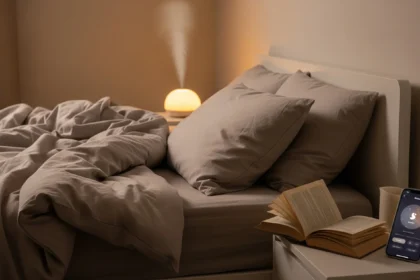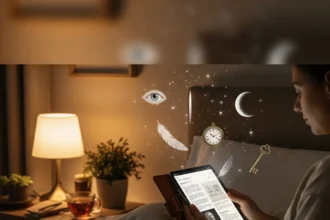Ah, sleep. That elusive, often underestimated third of our lives. We chase it, we crave it, and sometimes, despite our best efforts, it seems to play a perpetual game of hide-and-seek. But what if the key to unlocking truly restorative sleep wasn’t about more effort, but about a deeper understanding of our own innate rhythms? What if the secret lay in harmonizing with our very own body clock?
For centuries, humanity has lived by the sun, rising with its ascent and retreating into slumber with its descent. Yet, in our modern, electrified world, we’ve increasingly severed that ancient connection. We burn the midnight oil, scroll endlessly through glowing screens, and push our limits, all while wondering why we feel perpetually tired, foggy, and out of sorts. The answer, often, is a misalignment with our circadian rhythm – the sophisticated internal master clock that orchestrates nearly every biological process within us over a roughly 24-hour cycle.
The Symphony Within: Unveiling the Circadian Rhythm
Imagine your body as a magnificent orchestra, each instrument playing its part in perfect synchronicity. The circadian rhythm is the conductor, ensuring that hormones are released at the right time, body temperature fluctuates optimally, and cognitive functions peak when needed. This incredible internal timekeeper isn’t just about sleep and wakefulness; it influences digestion, metabolism, cell regeneration, immune response, and even mood. Disrupt this conductor, and the entire symphony can devolve into discord.
At the heart of this intricate system lies the suprachiasmatic nucleus (SCN), a tiny cluster of about 20,000 neurons nestled deep within your hypothalamus. Often dubbed the “master clock,” the SCN receives direct input from your eyes, specifically specialized photoreceptor cells that detect light, even when you’re not consciously perceiving images. This light signal is the primary “zeitgeber” – the German word for “time-giver” – that calibrates your internal clock to the external world.
Think of it like this: every morning, as the sun rises, light hits your retina, sending a signal to the SCN. This signal tells your master clock, “It’s daytime! Time to be awake and alert.” Conversely, as darkness falls, the absence of light prompts the SCN to signal the pineal gland to release melatonin, the hormone that gently lulls you into sleep. This elegant dance between light and darkness is the cornerstone of a well-tuned circadian rhythm.
The Modern Dilemma: When Our Clocks Go Awry
Our ancestors didn’t have to contend with the relentless glow of smartphones or the temptation of late-night Netflix binges. Their lives were intrinsically linked to natural light cycles. Today, we live in a perpetual “indoor summer,” bathed in artificial light long after the sun has set. This constant exposure to light, especially blue light emitted from screens, suppresses melatonin production, signaling to our SCN that it’s still daytime, even when it’s 11 PM.
Consider Sarah, a graphic designer who loved working late into the night, fueled by caffeine and the quiet hum of her computer. She’d often find herself still wired at 2 AM, only to drag herself out of bed at 8 AM, feeling groggy and unrefreshed. Her weekend “catch-up” sleep never seemed to fully erase the deficit. Sarah wasn’t lazy; she was fighting a losing battle against her own biology. Her constant exposure to artificial light after dark was confusing her body clock, delaying her melatonin release, and preventing her from entering the deep, restorative stages of sleep.
The consequences of a chronically misaligned circadian rhythm extend far beyond just feeling tired. Research has linked circadian disruption to a myriad of health issues, including increased risk of obesity, diabetes, cardiovascular disease, mood disorders, and even certain cancers. It compromises our immune system, making us more susceptible to illness, and impairs cognitive functions like memory, focus, and problem-solving. In essence, a disregulated body clock doesn’t just make us feel bad; it actively makes us unhealthy.
Syncing Your Symphony: Practical Strategies for Circadian Harmony
The good news is that while modern life presents challenges, mastering your circadian rhythm is entirely within your grasp. It requires a conscious effort to realign with the natural world, but the payoff – enhanced energy, sharper focus, improved mood, and profound restorative sleep – is immeasurable.
1. Embrace the Morning Light: This is perhaps the most powerful “zeitgeber” you can leverage. Within 30-60 minutes of waking, expose yourself to natural light. Step outside, open your curtains wide, or even sit by a bright window. This early morning light signals to your SCN that the day has begun, effectively setting your internal clock and kickstarting your cortisol production, which helps you feel alert and energized. Resist the urge to reach for your phone first; let the sun be your first interaction.
2. Strategize Your Light Exposure Throughout the Day: While morning light is crucial, consistent light exposure during the day is also beneficial. Work near a window, take short walks outdoors, or simply ensure your indoor environment is well-lit. Think of it as reinforcing the “daytime” signal to your body clock.
3. Dim the Lights (Literally) as Evening Approaches: This is where many of us falter. As the sun sets, begin to reduce your exposure to bright, artificial light. Dim the overhead lights, use warmer-toned bulbs, and consider investing in “blue light blocking” glasses if you must use screens in the evening. The goal is to send a clear signal to your body that darkness is approaching, allowing melatonin production to begin its natural ascent. Ideally, aim to power down all screens at least an hour or two before bed. This might sound drastic, but the difference in sleep quality can be profound.
4. Consistency is King (and Queen): Your circadian rhythm thrives on regularity. Try to go to bed and wake up at roughly the same time every day, even on weekends. While the occasional deviation is inevitable, a consistent sleep schedule helps to solidify your body clock’s rhythm. Imagine trying to teach a child a new skill; consistency in practice is key, and your body clock is no different.
5. Mind Your Melatonin, Naturally: While melatonin supplements are available, focusing on natural production is always preferable. Beyond light management, certain lifestyle choices support healthy melatonin levels. Avoid heavy meals close to bedtime, limit caffeine intake in the afternoon and evening, and moderate alcohol consumption, as it can disrupt sleep architecture.
6. Create a Sleep Sanctuary: Your bedroom should be a haven for rest. Ensure it’s dark, cool, and quiet. Blackout curtains can be a game-changer, especially in urban environments. Keep the temperature between 18-20°C (65-68°F), as a cooler environment promotes sleep. Remove any sources of light, even small LED indicators, and consider using earplugs or a white noise machine if your environment is noisy.
7. Movement Matters: Regular physical activity, especially in the morning or early afternoon, can significantly improve sleep quality. Exercise helps to regulate body temperature and can deepen the restorative stages of sleep. However, avoid intense workouts too close to bedtime, as they can be stimulating and raise your core body temperature, making it harder to fall asleep.
8. The Power of Rituals: Just as a bedtime story signals to a child that it’s time to wind down, a consistent pre-sleep ritual can signal to your body that sleep is approaching. This might include a warm bath, reading a physical book (not on a screen!), gentle stretching, or listening to calming music. These rituals help to shift your mind and body into a relaxed state, preparing you for slumber.
The Ripple Effect: Beyond Just Sleep
As you begin to implement these strategies, you’ll likely notice the positive changes extending beyond just your sleep. When your circadian rhythm is optimized, your energy levels stabilize throughout the day, preventing those afternoon slumps. Your mood improves, as sleep is intrinsically linked to emotional regulation. Your cognitive functions sharpen, making you more productive and creative. You might even find yourself making healthier food choices, as sleep deprivation can increase cravings for unhealthy foods.
Jessica, a busy marketing executive, initially scoffed at the idea of waking up with the sun. Her schedule was demanding, and she prided herself on being able to function on minimal sleep. But persistent fatigue and a nagging feeling of “brain fog” led her to experiment with circadian rhythm alignment. She started by simply opening her curtains first thing and taking a short walk. Gradually, she shifted her screen time, investing in blue-light blocking glasses for her late-night work sessions. Within weeks, she noticed a remarkable difference. She woke up feeling genuinely refreshed, her focus at work improved, and she no longer relied on multiple cups of coffee to get through the day. “It’s like I finally found the ‘on’ switch for my body,” she shared, “and everything just feels… smoother.”
Mastering your circadian rhythm isn’t about rigid adherence to a perfect schedule; it’s about cultivating an intuitive understanding of your body’s natural rhythms and making conscious choices that support them. It’s a journey of self-discovery, a gentle re-calibration with the ancient wisdom encoded within our very being.
In a world that constantly pulls us in different directions, often away from our natural inclinations, choosing to align with our body clock is an act of profound self-care. It’s an investment in your health, your happiness, and your potential. So, as the sun dips below the horizon tonight, and the moon begins its quiet ascent, consider the symphony within you. By honoring your internal conductor, you don’t just achieve optimal sleep; you unlock a more vibrant, energized, and truly harmonious life.
Disclaimer: The information provided in this article is for general informational purposes only and does not constitute medical advice. It is not a substitute for professional medical advice, diagnosis, or treatment. Always seek the advice of your physician or other qualified health provider with any questions you may have regarding a medical condition. Never disregard professional medical advice or delay in seeking it because of something you have read on this website.














